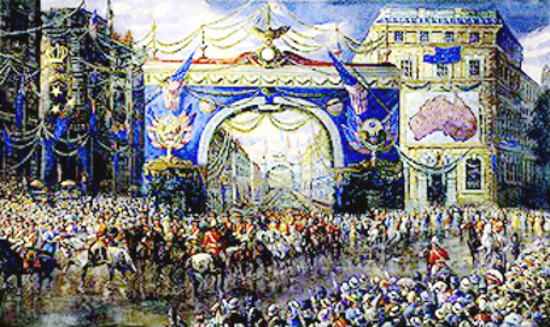Project Description
1888-1908
Tuesday, 1st January, 1901 was a day of tremendous excitement, for it was Commonwealth Day, with Australia celebrating “the birth of a New Year, the birth of a new century, and the birth of a new nation”. Sydney was the centre of the main festivities.
Back in 1889, Parkes had stressed the need for a “great national government for all Australia”. He said that is was the time for “One people, one flag, one destiny”. But it wasn’t until now that his vision became a reality.
This painting depicts the procession through the city to Centennial Park for the proclamation of the Commonwealth of Australia, illustrating a city that had “put on her carnival costume of many colours”. Indeed, Sydney was decorated like never before, overflowing with patriotic signs and banners. Ten commemorative arches were erected at key points on the route of the procession and Sydney became known as “a city of arches”. There were half a million people watching almost five kilometres of procession as it would its way from the Domain to the Federation site in Centennial Park.
From Pitt Street began the “Avenue of Nations”. The “French Avenue” was entered after passing under the French Arch. The skyline of the arch is Gothic, and on its apex is displayed the French coat-of-arms, backed by French and Australian flags. A crown surmounts the armorial shield. On the arch and drapery are words in silver and shields inscribed with the names of large French cities having direct commercial relations with Australia. The whole of the avenue was decorated with French and Australian flags and tricolour festoons extending across Pitt Street. A committee representing the French citizens of Sydney had organised this splendid display.
Then the procession reached the American Arch at the comer of Pitt and Hunter Streets, seen at the centre of this painting. The French Arch can be seen in the distance behind it. As the procession passed under the handsome structure, erected by the American citizens as the tribute from the United States to the Australian Commonwealth, it encountered the same note of admiration and exultation from thousands of throats as before. The American “star-spangled banner” was everywhere. Large crowds had congregated at the junction of Pitt and Hunter Streets and around the arch, whilst windows and every accessible point, including roofs, were occupied by sightseers.
The arch had massive flanking shafts, with a carriageway of 6.7 metres wide by 7.6 metres high. The ground work of almost the whole structure consisted of green foliage. The emblems and flags were all of the United States. On the northern face of the archivolt appeared the message: “The United States of America greet United Australia” and on the southern face; “Hail to the New Born Commonwealth”. The keystone of the arch was a lion’s head holding in the mouth a tablet on which was inscribed the year of union: “1901”. Atop the pediment perched the United States eagle with spreading wings of 4.9 metres from tip to tip. Above all, suspended at an elevation of 16.8 metres, the United States ensign fluttered high from a burnished mast.
The arch was erected opposite the Sydney Morning Herald office, on the right of the painting, with the words “One People One Destiny” written across a pink-tinted map of Australia on the corner frontage of the building, covering the second floor windows. Flags were arranged around the edges of the map and drapings. To the left is the Union Bank and the Empire Hotel.
